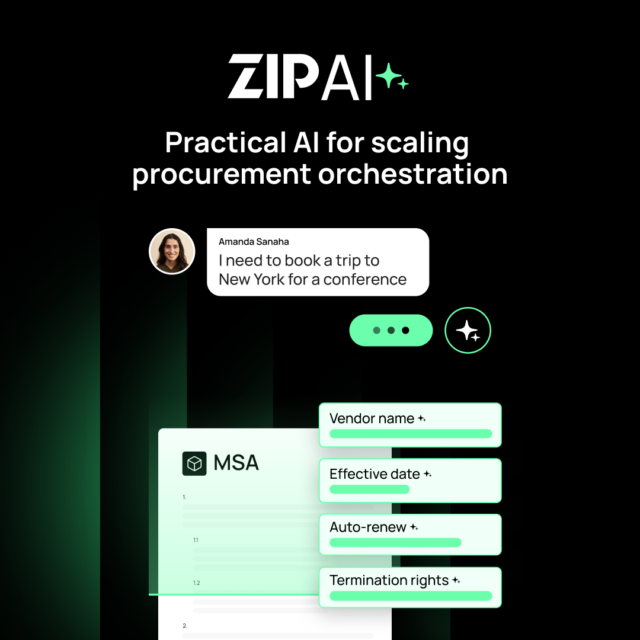2020 was a year of significant disruption and change.
Many people and businesses experienced their toughest years yet amid lockdowns and global restrictions. For procurement and supply chain, the industry was one of the hardest hit.
But despite catastrophic turbulence on an unprecedented scale, there was still opportunity to be uncovered.
Enter Zip.
The rise of Zip
Zip is a world-leading intake-to-pay suite which provides a single front door for any employee to initiate a purchase or vendor request. The company helps businesses gain clear and timely visibility across all purchases, while dramatically improving the employee experience. The platform’s no-code configuration and intelligent workflows integrated across disparate systems enable businesses to automatically route requests for faster approval across finance, legal, procurement, IT, security and other teams.
Zip was founded in July 2020, just a few short months after the beginning of the COVID-19 pandemic. Lu Cheng, Co-Founder and Chief Technology Officer at Zip, admits his company’s starting point was “interesting” but without being born against the backdrop of the pandemic, Zip wouldn’t have been able to get off to such a fast start.
Using Covid
“We certainly wouldn’t have been able to have the number of conversations with procurement leaders that we had in the early days,” he discusses. “The company being formed during Covid helped with our own resilience, and it shone a light on the importance of procurement as a strategic function. Business continuity has been so much more important for businesses — this is demonstrated by the last five to 10 years, where the number of vendors has grown dramatically. Companies are increasingly focused on their competitive advantage and outsourcing more of their work to vendors. They’re no longer on the software side of things, and instead of building all software and technology in-house, are leveraging third-party vendors for things like new R&D development. Today, one of the reasons you see so many SaaS providers is because the majority of companies are not building AI in-house.”

Cheng reflects on a decade ago when he was working at Airbnb and the level of transformation the space has undergone in the past few years. “That certainly wasn’t the case when I was at Airbnb,” he reveals. “We had over 4,000 engineers and we built our own AI platform with AI data. But today, companies are focused on outsourcing more of that work with vendors. It impacts other verticals too, like life sciences, financial services, manufacturing, retail and even marketing companies, which are leveraging external marketing and design agencies more and more.”
Gen AI boom
And the newest and most talked about form of technology in today’s world is generative AI. Natural language processing (NLP) tools such as ChatGPT are being heavily considered by many procurement functions as a way of saving time and money. According to Cheng, he has witnessed first-hand how the demand for machine learning processes like Gen AI has skyrocketed industry-wide and beyond.
“A lot of the acceleration of AI today is due to the quality and level of output, which has dramatically increased over the last few years, especially in the past year and a half alone,” Cheng explains. “NLP wasn’t very well leveraged before because the use cases weren’t broad enough and you had to spend a lot of effort to train various specific models. The rise of compute power, the ability to support and calculate a large amount of data and draw it from a wide knowledge base and the quality of output has been significantly better, which is why we’re seeing many more general purpose applications built on top.”
Scaling efficiency
While Gen AI has been widely praised for the efficiency it brings, the concern surrounding hallucinations remains. Hallucination data is incorrect or misleading results that AI models create. These could be caused by a range of reasons such as insufficient training data, incorrect assumptions made by the model, or biases that the data has used to train the model. Cheng explains that the way Zip’s product works is by providing companies with two key elements that contribute to accurately training AI models.
“First, Zip provides companies with one entry point for any employee to engage with procurement intake. The second thing we provide with our workflows is orchestration and visibility. We are taking a lot of processes that happen offline and bringing them online into a very clear workflow while digitising the process,” he reveals. “At a broad industry level, in the next one to two years there will be very rapid developments and improvements in the accuracy and quality of generative AI data and at Zip, we are ahead of that curve.
Keeping the human in the loop
“Where generative AI comes in and why we’re very strategically positioned to take advantage of Gen AI: we have all of the data to automate those workflows. The first product we launched with Gen AI was around documents. If you look at where the bottlenecks and challenges in procurement are, there are a lot of manual reviews that happen. Legal may spend two to three hours reviewing a single MSA — checking the box against 50 to 60 different risks that the company doesn’t want to be exposed to. The security and compliance teams may be reviewing documents around the company’s security posture information as a business and scanning against those different things.
“With our generative AI capabilities, you can scan 100 different risks within 10 seconds automatically, and report the results back to generate valuable business insights along the way. The thing that’s really important is that this is not automating away any type of work, it’s just making it easier and faster. The way our interface works is that there is still a human involved, reviewing the results of Gen AI, meaning you can dramatically reduce the time it takes for a security or legal review that previously took a couple of hours. The human-in-the-loop aspect is still very important today.”

Meeting challenges head-on
For Cheng and Zip, time-to-value holds the key. Upon starting the company almost four years ago, Cheng explains that due to procurement’s complex workflows across the entire business, it was a challenging start to life at Zip. “The purchasing process varies based on a number of factors including the category of spend, which subsidiary is making the purchase and where you’re located. It’s going to be a very different process purchasing something that’s $10,000 versus $500,000,” explains Cheng. “It also changes if key company information is shared with the supplier. One thing we found is that the complexity of procurement made time-to-value a unique challenge for us to solve for our customers.”
Future-focused procurement
Just four years into its founding, Zip has significantly reduced time-to-value to between eight and 12 weeks. Cheng explains that it’s not only about adopting the product but also making sure the product works for all of a customer’s use cases. “It’s really about rethinking and taking a closer look at your process along the way,” says Cheng. “We have a world-class product that’s able to support almost any kind of use case out there as well as meet any type of workload, including enterprise-level workloads and scalability. We have this working for over 350 customers from high-growth late-stage startups all the way up to our global 2000 customers. We’ve built a world-class solutions team that advises customers on how to create the right processes and, how to best implement the system and best practices.”
Looking ahead, Zip is showing no signs of slowing down. Indeed, the company recently announced new generative AI capabilities for finance and procurement teams. Cheng explains that Zip believes generative AI holds the key to transforming the entire intake-to-pay process. “We’ve made a big bet in leveraging Gen AI to improve all aspects of the platform,” he says. “It’s really the beginning for us l and Gen AI is a core area of focus — continuing to bring generative AI to all parts of the intake-to-pay suite from intake to sourcing to vendor management to helping assess supplier risk to some of our newer products like procure-to-pay. It’s about making that entire process seamless and automated as much as possible.”











